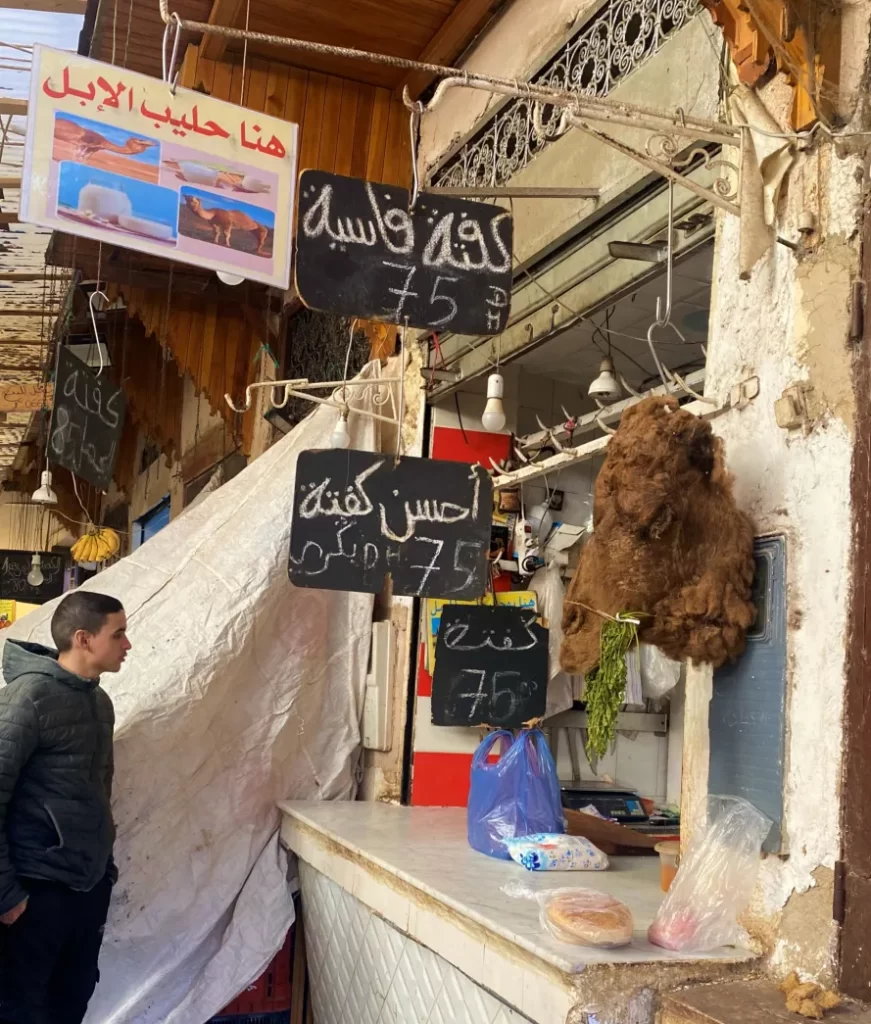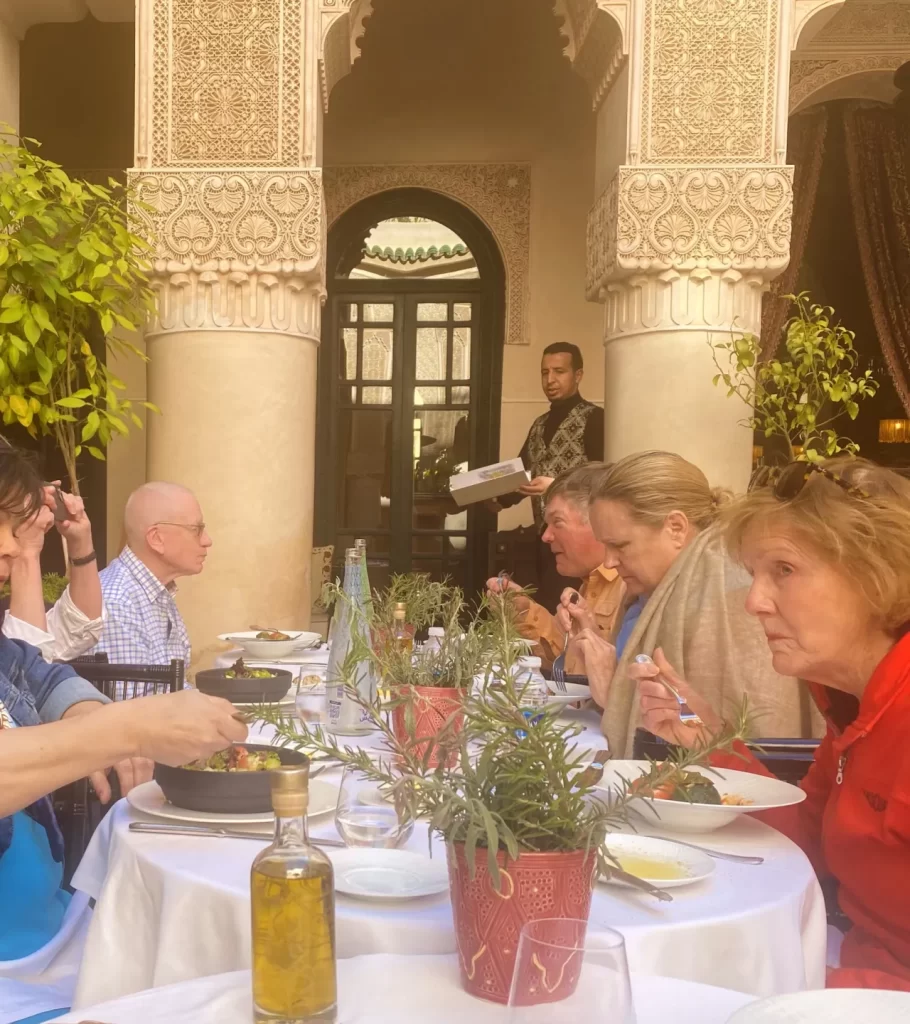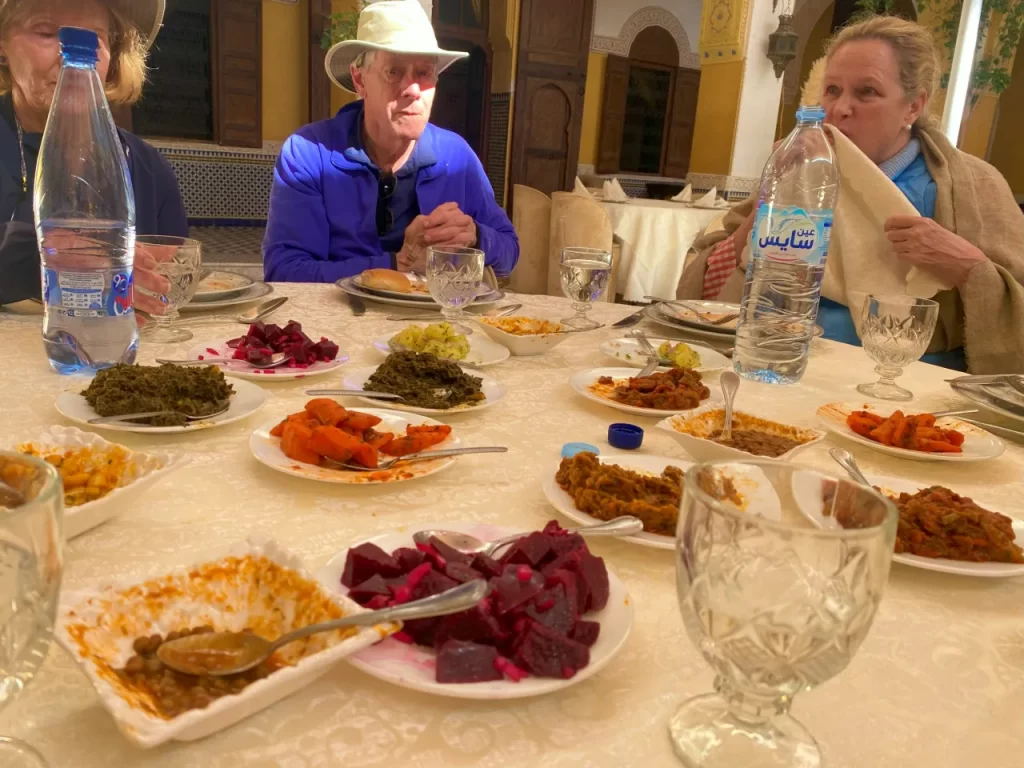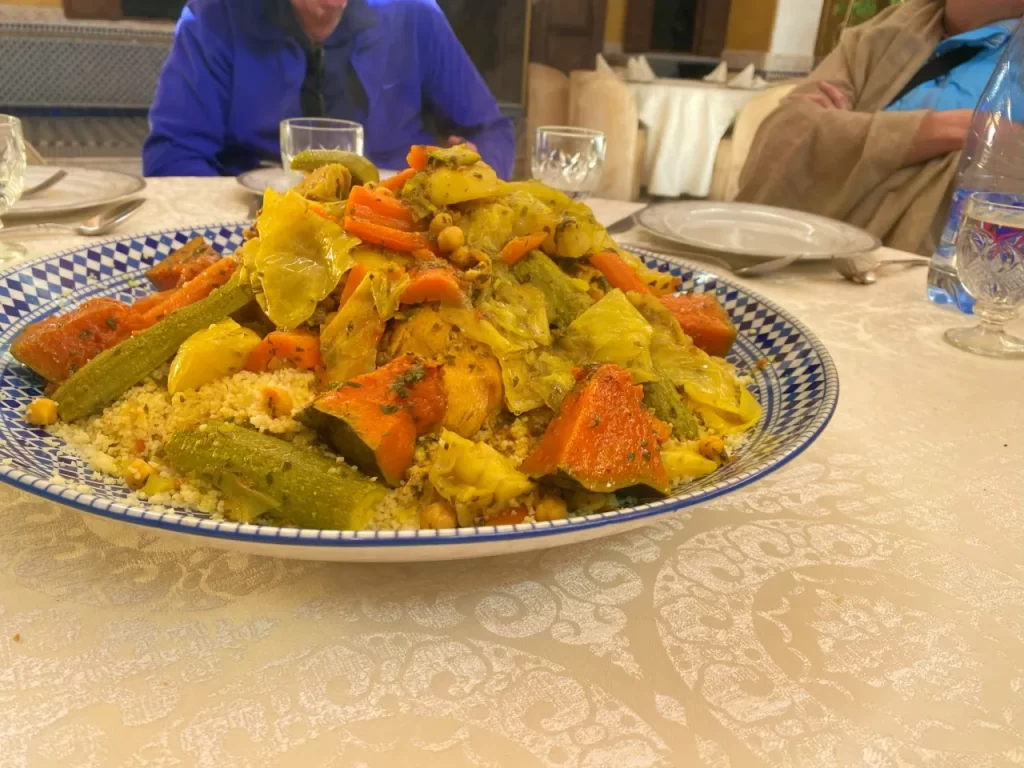Taste exotic dishes of Morocco with unusual combinations of ingredients
Cuisine in the African nation often sweet-and-savory thanks to mix of herbs and spices

Camel meat, which tastes similar to beef, is sold at a souk devoted to edibles in Marrakesh’s medina in Morocco. (Janet Podolak)
Sliced oranges dusted with cinnamon, a huge variety of dates and tart preserved lemons served with luscious green olives were among the taste combinations I experienced during a recent visit to Morocco, a stunningly beautiful country in North Africa. I’ve attempted to duplicate a few of the dishes to share with readers wishing to taste something of that exotic place.
My 12-day trip with Odysseys Unlimited included my daughter, Sascha, and me with six other Americans and included most meals as we traveled in an air-conditioned mini-bus along ancient caravan routes to Casablanca, Rabat, Meknes, Fes and Marrakesh and into the High Atlas mountains and the Sahara Desert.
We were advised not to drink or brush our teeth in the tap water, but bottled water was available at every meal and at hotels, as well as in a cooler in our vehicle. Locals, however, experienced no issues with the public water. Wine and other adult beverages, prohibited to Muslims, are available to tourists but never are served within sight of a mosque, where the Muslim population prays five times daily.

Meals on our tour in Morocco often were served in the open-air central courtyard of a riad, a one-time private home with rooms surrounding a fountain. (Janet Podolak)
Every meal and many transactions begin with an offer of hot mint tea, poured from high above into small glasses embossed with a trim that keeps the heat from burning the hands. Customarily, it’s very sweet, but you can request it without sugar.
Fresh fruits and vegetables are widely available, but I ate them cooked and avoided lettuce and foods washed in the local water.
The domed earthenware tagine lends its name to a common stew of seemingly endless variety. The meat frequently is lamb but can be chicken, beef or even camel. It’s never pork, because like alcohol, pork is prohibited for Muslims. Restraint must be practiced for the numerous cooked vegetable dishes of beets, eggplant, potatoes and spinach presented as appetizers in small tagines before the main dish is placed on the table for diners to share.

An assortment of cooked and spiced vegetables is offered as an appetizer in small dishes during a visit to Morocco. (Janet Podolak)
The meat is buried in the middle of the tagine as it cooks with a combination of sweet and savory vegetables and spices. Consider dried apricots, cinnamon, nutmeg and sliced almonds browned in butter prepared with lamb, saffron, turmeric, tomato paste and scallions or a pot roast-style beef cooked with prunes and figs. Herbs and lemon juice are in everything, as are green olives.
A Dutch oven or heavy pan with a cover can substitute for a tagine.
Couscous, considered the national dish of Morocco, is traditionally served on Fridays after the midday prayers. It’s often part of the tagine.

A tagine of chicken with pumpkin, onion and zucchini is served over couscous in Morocco. (Janet Podolak)
Ras el hanout, an herb-and-spice mixture added to many dishes, was one of my purchases to take home from Marrakesh after I discovered it at Herboristerie Almas in the city’s medina.
I also found a recipe for the fragrant mixture that can be kept tightly sealed in the fridge for up to a month. Its components add a delicious sweet-but-earthy flavor to chicken and many other dishes.
Rosewater and preserved lemons both can be ordered online. Rosewater can be used as a facial spray, to scent the air or to mist fresh slices of orange before sprinkling with cinnamon.

Orange slices sprinkled with cinnamon were a delightful combination for dessert during a recent visit to Morocco. (Janet Podolak)
Preserved lemons are cured in salt with sugar and will keep in the refrigerator in a tightly covered jar for six months. The lemons soften as they are pickled and when used add a citrusy brightness to a host of dishes, stews and even sandwiches.
Odysseys Unlimited hosts dozens of small group tours throughout the world. The next 12-night Moroccan Discovery tours are in March and April. Learn more at Odysseys-Unlimited.com and 888-370-6765.
Recipes
Ras el Hanout
(Makes 12 servings)
Ingredients
1 teaspoon salt
1 teaspoon ground cumin
1 teaspoon ground ginger
1 teaspoon ground turmeric
¾ teaspoon ground cinnamon
¾ teaspoon freshly ground black pepper
½ teaspoon ground white pepper
½ teaspoon ground coriander seed
½ teaspoon ground cayenne pepper
½ teaspoon ground allspice
½ teaspoon ground nutmeg
¼ teaspoon ground cloves
Instructions
Mix salt, cumin, ginger, turmeric, cinnamon, black pepper, white pepper, coriander, cayenne, allspice, nutmeg and cloves in a small bowl until evenly blended. Store in an airtight container for up to 1 month.
Preserved Lemons
Ingredients
10 whole lemons, organic if possible
½ cup Kosher salt
2 tablespoons sugar
2-½ cups lemon juice
2 dry bay leaves
2 tablespoons whole peppercorns
Instructions
Slice off the tops and bottoms of scrubbed lemons. Keeping lemons vertical, score them in quarters but leave them attached at the bottom.
Spread lemons and stuff them with salt-and-sugar mixture, rolling them in the mixture when done.
Cover the bowl with plastic wrap and refrigerate overnight.
Transfer the salted lemons and their juices to a large sterilized canning jar.
Press the lemons down firmly into the jar.
Add peppercorns and a few dry bay leaves.
Add fresh lemon juice to fill the jar and cover the lemons (you’ll use the juice of another 8 lemons or 2 ½ cups of fresh lemon juice). Be sure to submerge the lemons so that the lemon juice covers the very top.
Cover the jar tightly and refrigerate for 3 weeks and up to 1 month before consuming.
The lemons will soften and mellow as they sit in the pickling liquid. Salt-preserved lemons will keep in the fridge for up to 6 months.
Quick Chicken Tagine
Ingredients
4 pounds chicken thighs
3 tablespoons ras el hanout
2 tablespoons olive oil
1 onion, chopped
3 cloves garlic, chopped
1 tablespoon chopped cilantro
1 preserved lemon, sliced
¼ cup raisins
½ cup dried apricots, chopped
½ cup green olives
½ cup low-sodium chicken broth
Instructions
Pat the chicken pieces dry, then season lightly with salt.
Rub the ras el hanout spice mixture over the chicken pieces, rolling them in it if any remains.
Leave at room temperature for 40 to 45 minutes or, if there’s time, cover and refrigerate for 2 hours or overnight.
Heat a bit of high-quality extra-virgin olive oil over medium-high heat in a Dutch oven until shimmering but not smoking, then brown the chicken well on both sides. If the skin is on, begin by browning the skin side first, then turn it over.
Lower the heat and add onions, garlic and cilantro.
Let those sweat briefly, then add lemons, olives and dried fruit. Add the chicken broth.
Cover and let cook for 30 to 45 minutes or until chicken is fully cooked through and registers 165 degrees on an instant-read thermometer.
For garnish add more fresh cilantro and toasted almonds.
— Recipes adapted from the mediterraneandish.com




Recent Comments